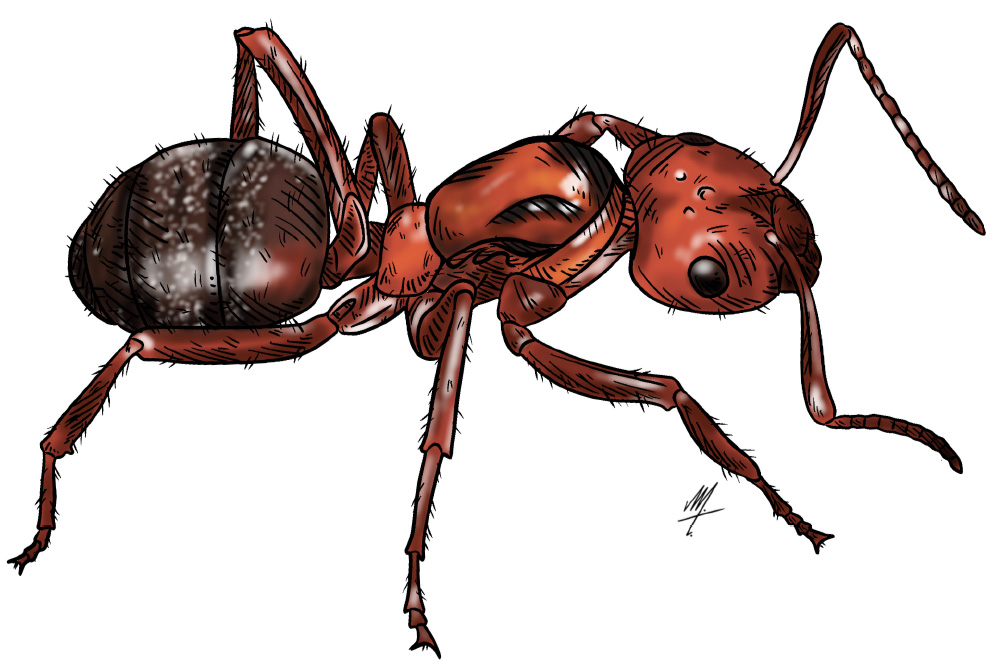Exploring the World of Blood Red Field Ants
Imagine a tiny insect painted in the brightest shades of red, scurrying through fields and forests. This is the world of the Blood Red Field Ant, a place full of adventure and surprises. These ants might be small, but they play a huge role in the great outdoors. Join us as we explore the secret life of these vibrant insects, discovering their unique characteristics and the vital part they play in our ecosystemAn ecosystem is a community of living organisms, like insects and birds, and non-living components, like water and rocks, that interact with each other in a specific area. Learn More.
Meet the Colorful Blood Red Field Ant
Known to scientists as Formica sanguinea, the Blood Red Field Ant is a small but noticeable creature. They measure about 4 to 8 mm, making them slightly larger than some other ant species. Their most striking feature is their vibrant red color, which ranges from a deep, rich burgundy to a bright, fiery red. This not only makes them beautiful but also helps them blend into certain environments, like red clay or dark soil.
Their Ingenious Homes
When it comes to building homes, Blood Red Field Ants are quite creative. They construct their nests in open spaces like meadows or the edges of forests, preferring sunny areas. They build large, dome-shaped mounds from soil, which can be quite large compared to the ants themselves. Inside these mounds, there are numerous chambers and tunnels, creating a complex and efficient living space for the colony.
A Colony of Hard Workers
Every ant in the colony has a specific role to play. The queen is the mother of the colony, laying all the eggs. Worker ants, which are all females, do various jobs like gathering food, caring for the young ants (larvae), and protecting the colony. They work together like a well-oiled machine, ensuring the survival and success of their communityA community is all the living organisms in an ecosystem. This includes animals, plants, fungi, and bacteria. It does not include dirt, rocks, water, and other non living things. Learn More.
What’s on the Ant Menu?
Blood Red Field Ants are omnivoresOmnivores are animals that eat both plants and meat. They are like the flexible eaters of the animal kingdom. Just as you can have a salad for lunch and a hamburger for dinner, omnivores enjoy a variety of foods. Learn More, which means they eat both plants and animals. Their diet includes other insects, sweet substances like nectar, and honeydew produced by aphids. They’re important in controlling pest populations and also help in pollination, making them crucial players in their ecosystem.
Tiny Environmental Guardians
These ants don’t just eat and build; they also help the environment in big ways. By spreading seeds, they assist in plant growth. Their nests aerate the soil, making it healthier for plants to grow. They also keep a check on the population of other insects, ensuring a balanced ecosystem.
Interactions in the Wild
Blood Red Field Ants have a unique relationship with aphids, protecting them in exchange for honeydew. However, life isn’t all sweet for these ants. They have to be on the lookout for predators like birds and larger insects and compete with other ant species for food and territory.
Expanding Their Kingdom
To grow their colonies, Blood Red Field Ants have an annual cycle where winged males and new queens fly out to mate. After mating, the new queens set off to establish new colonies, ensuring the spread and continuation of their species.
Survival Skills of the Blood Red Field Ant
These ants are adapted to survive in various environments. They can find food in tough conditions and have a strong sense of communication within the colony, using pheromones (chemical signals) to alert each other of dangers or food sources.
Overcoming Challenges
Despite their resilience, Blood Red Field Ants face challenges like habitat loss due to human activities and environmental changes. However, their ability to adapt helps them survive and thrive in different conditions.
The Blood Red Field Ant is a small creature with a big impact on our world. From their bright red color to their intricate nests and their role in the ecosystem, these ants are truly fascinating. They help plants grow, keep other insect populations in check, and maintain the health of the soil. Their complex social structure and efficient teamwork are amazing to learn about. These tiny insects show us how every part of nature, no matter how small, is important and deserves our attention and respect.




